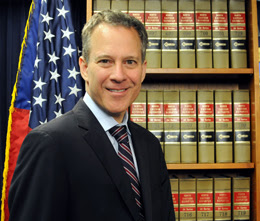STAFF REPORTS
news@allwnynews.com

Anticipating major changes to federal immigration enforcement, on Jan. 19, Attorney General Schneiderman released legal guidance to provide localities and local law enforcement with model laws and policies to become sanctuary jurisdictions. Since the guidance was issued, at least 9 localities across New York State have used it to protect their immigrant communities, regardless of new federal enforcement practices. Those localities include Rochester, Syracuse, Ithaca, Albany, Kingston, Newburgh, Hudson, White Plains, and Irvington.
“Our legal guidance is clear: President Trump does not have the authority to unilaterally transform state and local police into federal immigration agents,” said Attorney General Schneiderman. “We know that effective policing – and safe neighborhoods – depend on building and maintaining trust with the communities our officers bravely serve. Yet President Trump’s draconian immigration policies seek to undercut that trust, threatening to drive immigrant communities underground and make them fearful to report crimes, serve as witnesses, and more. The fact that local governments across New York State are utilizing our guidance sends a strong message that we will do what it takes to protect our immigrant communities.”
Following President Trump’s executive orders and DHS memos, a number of local governments and law enforcement agencies contacted the Attorney General’s office to confirm that the Jan. 19 legal guidance still applied.
“After closely reviewing the Executive Orders and DHS Memoranda, the NYAG has concluded that none of the provisions contained therein alter or invalidate the analysis and model provisions set forth in the Guidance. Localities still retain substantial discretion to limit their involvement in federal immigration enforcement. The NYAG issues this Supplemental Memorandum to assure localities that they may continue to consult the Guidance to keep our communities—including our immigrant neighbors—safe and secure,” the Attorney General’s supplemental legal memo states.
Click here to read the updated guidance.
The model provisions offered by the Attorney General’s Civil Rights Bureau make clear that local New York law enforcement agencies can limit their participation in federal immigration enforcement activities in several ways, including by: (1) refusing to enforce non-judicial civil immigration warrants issued by Immigration and Customs Enforcement (“ICE”) or Customs and Border Protection (“CBP”), (2) protecting New Yorkers’ Fourth Amendment rights by denying federal requests to hold uncharged individuals in custody more than 48 hours, (3) limiting access of ICE and CBP agents to individuals currently in custody, and (4) limiting information gathering and reporting that will be used exclusively for federal immigration enforcement.
Attorney General Schneiderman’s model procedures were issued to assist local governments and law enforcement agencies in fulfilling our joint responsibilities to protect vulnerable communities and promote public safety. The guidance also intends to insulate local authorities from potential legal liability arising out of Fourth Amendment (unlawful detention) claims and ensure that local governments are not forced to spend limited local resources on increased federal immigration enforcement efforts that do not improve public safety.
The updated legal guidance follows a number of other steps taken by Attorney General Schneiderman to protect New York’s immigrant communities in recent months, including the following.
- Last month, Attorney General Schneiderman and State Education Commissioner MaryEllen Elia sent guidance to New York school districts detailing their duty to comply with existing state and federal laws that ensure the rights of immigrant children to attend public schools without fear of reprisal. The Attorney General has also secured settlements with 24 school districts across the state to ensure equal access to education regardless of immigration status.
- Last week, Attorney General Schneiderman announced that he will join the lawsuit in the Western District of Washington against President Trump’s second immigration ban.
- After the election and amid a rise in hate incidents across the nation, the Attorney General issued an urgent bulletin to local law enforcement officials statewide to provide guidance in identifying and prosecuting hate crimes.
- Given a rise in reported immigration-related scams in recent months, with scammers attempting to prey on immigrants’ fears, Attorney General Schneiderman issued a consumer alert.
“Rochester is the home of Frederick Douglass and Susan B. Anthony, so the fight for inclusion and equality is nothing new to us,” said Rochester Mayor Lovely Warren. “As an African American woman and the child of an immigrant, I am keenly aware of what discrimination feels like, and equally aware that it has no place or part in the ‘American Dream.’ In 1986, the Rochester City Council passed a resolution declaring us a ‘City of Sanctuaries,’. I proposed to our current City Council to bring this resolution up to date and reflect Attorney General Schneiderman’s recommendations. A new resolution declaring Rochester to be a sanctuary city was adopted unanimously on Feb. 21, 2017. The Attorney General’s guidance was very helpful to our deliberations. I want to make it clear that in Rochester we are one community that is united and strengthened by our diversity, and no citizens should be denied access to jobs, safe and vibrant neighborhoods or quality educational opportunities simply because of who they are.”

